 |
|
|
| POULTRY WASTE MANAGEMENT |
| Back |
 Growing concentration of poultry units result in the production of poultry waste on a large scale. This also poses problems of handling and disposal for many poultry producers, with the public becoming more aware and concerned about environmental pollution. Two main types of wastes are produced by poultry enterprises depending on the rearing system adopted on the farm: poultry litter and cage layer waste.
Poultry litter is the waste from deep litter systems and does not have much nutritive value, since it contains mostly used litter material. Cage layer waste consists mainly of excreta collected under the cages, spilled feed and feathers. Growing concentration of poultry units result in the production of poultry waste on a large scale. This also poses problems of handling and disposal for many poultry producers, with the public becoming more aware and concerned about environmental pollution. Two main types of wastes are produced by poultry enterprises depending on the rearing system adopted on the farm: poultry litter and cage layer waste.
Poultry litter is the waste from deep litter systems and does not have much nutritive value, since it contains mostly used litter material. Cage layer waste consists mainly of excreta collected under the cages, spilled feed and feathers.
Value of poultry manure
| Source of manure |
Treatment |
Moisture content |
Organic matter |
Analysis dry basis % |
| N |
P |
K |
| Broiler |
Fresh. |
76% |
- |
5.66 |
1.5 |
2.06 |
| Hen |
Fresh. |
76% |
79.17 |
6.18 |
1.74 |
1.64 |
| Turkey |
Fresh. |
74% |
77.82 |
5.04 |
1.19 |
1.58 |
| Chemical Analysis of Poultry Manure |
|
| Ash |
26% |
| Crude fiber |
10% |
| Crude Protein |
33.5% |
| N-free extract |
22.5% |
Recycling poultry waste
- The use of poultry waste as a source of manure for crop production has been the preferred system for recycling nutrients.
- In recent years, poultry nutritionists have explored the possibility of recycling poultry waste as a feed for the poultry itself.
- Poultry droppings, until now considered as waste, or used sparingly as manure, may prove to be an alternative for conventional feed ingredients. Poultry excreta are commonly referred to as dried poultry droppings, cage layer excreta, dried poultry waste or dried poultry manure.
- Dried poultry waste reportedly contains about 30 per cent protein, of which about 60 per cent is from non-protein nitrogenous sources. It has more mineral value.
- Poultry waste has high water content and there is a need to develop suitable and economical processing technology to remove excessive moisture and destroy harmful pathogens from the organic waste.
- It is high in fibre and low in metabolizable energy. The true digestibility coefficient of crude protein in poultry litter is about 64 per cent. Some of the constituent amino acids were found to range from 24.7 per cent (for valine) to 76.4 per cent (for serine).
- The absorption of calcium and phosphorus was characteristic of the individual bird and ranged from 1.2-45.3 per cent for calcium and from 7.5-46.2 per cent for phosphorus.
- Poultry dropping may contain various types of microbial organisms and moulds. Therefore, before poultry manure can be recycled as poultry feed, it needs processing.
Methods of processing poultry waste
Drying
- Probably the oldest method of processing waste for refeeding is the drying of poultry manure in natural air conditions under sunlight.
- This is the cheapest and most feasible method in a tropical country.
- Moreover, fresh poultry droppings have lower moisture content than manure from other livestock, making sun drying the most effective processing method.
Methods of Drying
- Air-drying requires varying lengths of time depending on the climate and the level of humidity.
- Drying the manure with heat has also been attempted. The manure may be dried at temperatures ranging from 149-385oC. Drying with heat results in a highly significant loss of energy and significant loss of nitrogen.
- Thin bed drying of poultry manure to 30 per cent or lower moisture levels was found to prevent the breeding of flies, to reduce obnoxious odours and to maintain the nutrient value of the manure particles. The faster the manure is dried, the higher is the nitrogen value.
Heaping
Deep stacking of poultry waste produces considerable heat and had been shown to destroy coliforms. The maximum temperature was reportedly attained in 4-8 days. When litter from the broiler house is placed in a heap, the heat which subsequently develops is sufficient to destroy the pathogenic organisms that are present.
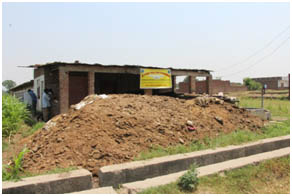 |
| Heaping of broiler litter
|
Composting
- Collecting poultry manure in pits under cages or slat or wire floors is gaining favour as a practical and economical way to handle poultry waste.
- The manure may be allowed to accumulate for several years through the process of composting. Aerobic bacterial action occurs. Many compost pits have been in operation for several years without manure removal. The top foot is composed of fresh manure, the bottom foot is in an anaerobic condition and the central portion is undergoing composting.
- The essential requirement in managing the deep pit is that the fresh, wet material be adequately aerated to remove the moisture.
- To further the composting process and prevent odour, the pit must be watertight so that seepage of water cannot enter.
- Care must be taken to prevent drinkers from leaking or overflowing into the pit, for such overflow prevents proper bacterial action in the accumulated wet manure.
- When the procedure operates correctly, there is little or no odour arising from the pits and manure removal may be delayed for years.
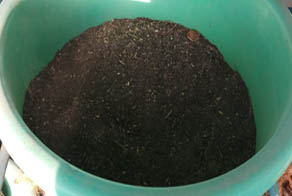 |
| Poultry waste compost
|
Pond disposal
- Fresh poultry manure may be flushed into an open, shallow pond. Bacterial action reduces the waste material to a smaller volume. As bacterial growth occurs only during the warm months, the use of ponds is seasonal. The resulting solution may be spread in its liquid state on farmland. When aerobic action takes place, the lagoon produces little odour; but as the sludge builds up, anaerobic activity takes place and odours may be pronounced.
- Further, in case of integrated farming, the poultry waste can serve as a feed for the fishes kept in the pond and growth of vegetation in the pond for fish feed is also enhanced by the use of poultry litter in pond.
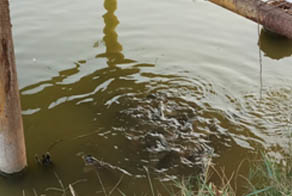 |
| Poultry waste as fish feed in pond |
Aeration
- The oxidation method is used for poultry by placing a continuous- flowing trough under the birds.
- Water is poured into the trough to keep the manure fluid and pumps keep the sludge circulating.
- The effluent is aerated by paddles.
- The addition of oxygen by the paddles increases the activity of aerobic bacteria, greatly reducing the incidence of any odours.
- After 4-6 months, the material is removed in liquid form and usually spread on the land. The material is practically odourless.
Disposal of Dead Birds
Dead birds must be removed from poultry houses on at least a twice-daily basis. An accurate count should be kept of birds collected and the number recorded in the farm diary. Dead birds on poultry farms should not be carelessly thrown out in the open. It will lead to the spread of infections and also cause major pollution problems. Typical methods of mortality disposal include burial, incineration, rendering, and composting. Many states have banned the use of burial pits, which historically have been used to dispose of dead birds. Incineration can be costly and raise air quality concerns, and the decreasing number of renderers further complicates disposal. The safe methods of dead bird disposal are
a. Incineration
The best method of disposal is proper incineration; this method ensures destruction of any infectious organisms and also eliminates any risk of noxious odors disturbing neighbors. It is likely not cost-effective, however, for most small flock owners to invest in a proper incinerator. Marginal farmers can opt for burning of the carcasses for disposal.
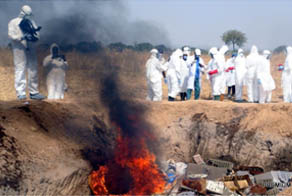 |
| Incineration of birds in open (however this practice should be followed only in emergencies)
|
b. Carcass Removal
Removing carcasses from the farm to another disposal area is another option. It is critical, however, that they be properly secured in a sealed container to prevent possible spread of any infectious organisms as they are transported. Some landfills may accept limited numbers of poultry carcasses, so this option can be explored. If using a disposal option, such as an incinerator, on another farm, it is critical that the mortalities be handled with care to prevent any spread of disease to poultry populations that might be on that farm.
c. Composting
Composting is yet another option for disposal of carcasses, but this option requires a great deal of care to ensure it is done properly. The compost area must be contained so that wild scavengers, including birds, cannot get at carcasses. The dead birds must be buried within the compost pile to ensure that good bacterial action can happen to break the carcass down. The temperature of the compost should be measured to ensure that it rises above 37° C for 5 days. Once the temperature starts to drop, the pile must be turned to encourage further bacterial action. When done properly, composting will eliminate a chicken carcass in just a few days.
 |
| Laying of carcass in compost bin (Source: Internet)
|
d. Burial
Burial may be allowed in some jurisdictions, but it is best to check with municipal regulations. If there is a high water table, then carcasses cannot be buried in that area. They must, also, be buried deeply enough to prevent scavengers from getting at the carcasses.
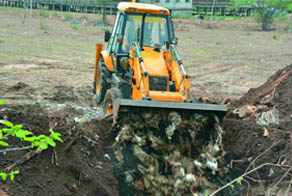 |
| Burying dead birds deep in soil
|
e. Pit disposal
- This is an effective and convenient method for disposal of dead birds which is within the means of poultry raisers.
- A decomposition pit can be used for small losses, but care should be taken in choosing the location of the pit:
- The pit should be a reasonable distance (150 feet) from the poultry houses and the well that provides the water supply.
- A pit 6 feet (1.83 m) in diameter and 6 feet deep (1.83m) is large enough to take care of one 10,000-capacity broiler unit.
- It is important that the roof or walls should not collapse easily.
- Flies and other insects must not be able to enter the pit and, above all, there must be no danger of small children falling into it.
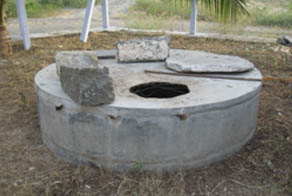 |
| Concrete pit for disposing dead birds
|
Points to keep litter in good condition
- Proper floor space to birds to ensure proper moisture in litter.
- Proper ventilation to remove excess moisture.
- The floor should be raised 0.3-0.5 m above the ground level to ensure seepage of water.
- Concrete flooring is preferred.
- Overhangs of the roofs must be and equate to protect the interior of the house from rainwater.
- Leaky and overflowing waterers should never be used. Waterers should be kept on horizontal plane.
Factors leading to poor litter quality
- Litter moisture
- Greasy capped litter
- Nitrogen in litter
- Drinker design and management
- Air change rate and house environment
- Litter material and depth
- Stocking density
- Nutrition
- Flock health.
Conditions associated with poor litter quality
- Pododermatitis
- Breast blisters
- Burnt hocks.
|
| Back |
|
|
Developed by :
|
Dr.Rahulpreet Singh
( M.V.Sc Scholar ) |
Dr. Pranav Kumar
(Assistant Professor)
|
Dr. Amandeep Singh
(M.V.Sc Scholar, IVRI ) |
|
|
|
|
|
|
Scroll
|
| Division of Veterinary and Animal Husbandry Extension Education Faculty of Veterinary Sciences and Animal Husbandry, R.S. Pura, SKUAST Jammu |
|

 Growing concentration of poultry units result in the production of poultry waste on a large scale. This also poses problems of handling and disposal for many poultry producers, with the public becoming more aware and concerned about environmental pollution. Two main types of wastes are produced by poultry enterprises depending on the rearing system adopted on the farm: poultry litter and cage layer waste.
Poultry litter is the waste from deep litter systems and does not have much nutritive value, since it contains mostly used litter material. Cage layer waste consists mainly of excreta collected under the cages, spilled feed and feathers.
Growing concentration of poultry units result in the production of poultry waste on a large scale. This also poses problems of handling and disposal for many poultry producers, with the public becoming more aware and concerned about environmental pollution. Two main types of wastes are produced by poultry enterprises depending on the rearing system adopted on the farm: poultry litter and cage layer waste.
Poultry litter is the waste from deep litter systems and does not have much nutritive value, since it contains mostly used litter material. Cage layer waste consists mainly of excreta collected under the cages, spilled feed and feathers.






